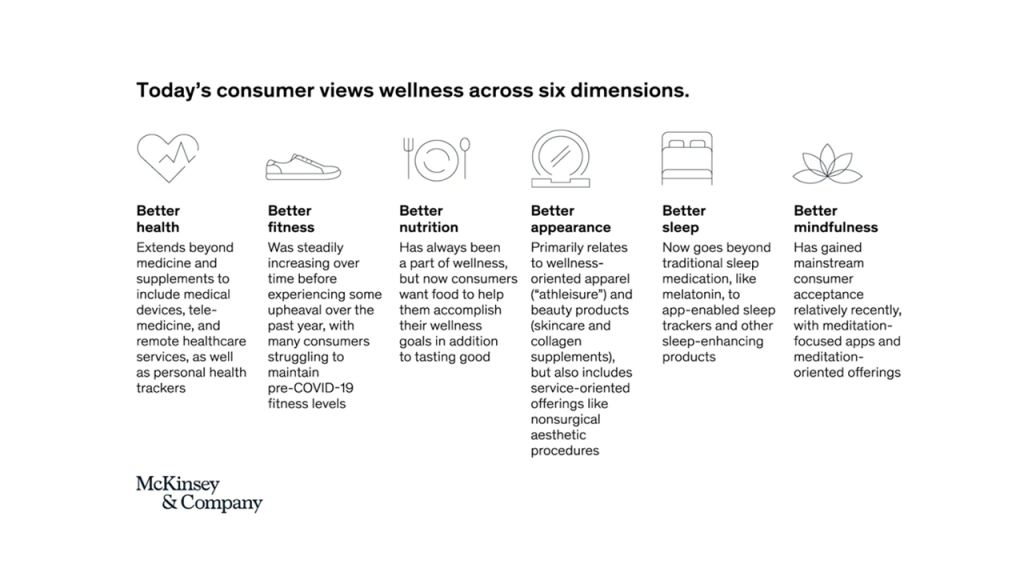Feeling Good: An Overview of the Global Wellness Market
(8 minute read)
Consumer perspectives of the concept of ‘wellness’ has evolved considerably over the last few decades to encompass a range of ideas over fitness, nutrition, sleep, physical and mental appearance. This blog draws from research from McKinsey and highlights some key features and trends in this market.
Consumer spending on personal spending has rebounded sharply after the pandemic. The global wellness market is estimated at US$1.5 trillion with an annual 5-10% growth rate. It is a crowded market and companies looking to gain from this market need some strategic approaches to understanding consumer behaviour.
Consumer Perspectives on Wellness
Consumer views on wellness currently ranges over six key areas:
- Better Health to encompass medicines, supplements, personal health trackers including data-driven apps and personal, self-monitoring medical devices.
- Better Fitness to include at-home solutions where lockdown has made gym attendance and outdoor sports activities difficult.
- Better Nutrition to include foods and related services that not only tastes good but also helps consumers attain their wellness goals.
- Better Appearance includes wellness-oriented apparel and beauty products and services from athleisure to anti-ageing to non-surgical aesthetic procedures.
- Better Sleep a relative newcomer in the category but a growing area of interest encompassing sleep aids, apps, and sleep-related equipment, accessories, products, and services.
- Better Mindfulness in the context of a global increase in mental health issues to include a range of offerings from apps to relaxation and mindfulness related products and services.

There are several interesting variations in this demand. Consumers from different countries prioritise different aspects of the above six categories. There is a growing trend towards a demand for more personalised services (e.g. tailored nutritional plans, counselling services).
Wellness consumers are also not a monolithic bloc. Enthusiasts are high-income consumers who are proactive about tracking and following new products and brands on multiple platforms including social media. Socially Responsible prefer to pay more for natural and environmentally sustainable products. Price Conscious think wellness is important but prefer to do rigorous price searches and seek out best value for money. Loyalists stick to familiar routines and brands while Passive are only marginally involved and don’t tend to actively follow any brands. The levels of commitment each consumer category has tends to drive their per capita spend.
Consumer Trends
Six trends are highlighted by the McKinsey research which has implications for companies across several industries from healthcare to fitness, nutrition, beauty, apparel, retail, and pharma.
Trend 1: Preference for natural / clean products: Consumers prefer natural / clean, chemical-free, and sustainable products in areas like cosmetics, food, skincare, vitamins and supplements.
Trend 2: Personalisation: Consumers tend to trade privacy for personalisation as an added value service, demanding tailored services in food, weight loss, nutrition, fitness, sleep, lifestyle, and mental health.
Trend 3: Digital: While some products like foods, multivitamins, supplements still have a strong retail presence in brick-and-mortar, apps and fitness wearables are almost entirely digital native.
Trend 4: Influencers: Major brands amongst wellness players are learning to leverage the power of social media influencers, especially those with strong links to nutrition and fitness.
Trend 5: Growing Demand for Services: The wellness market is seeing a growing demand for personalised services and experiences that address consumers’ physical and mental health needs and which work as a value-add on to already existing products.
Trend 6: Category Lines Blur and Converge: Consumers are not looking for a single product or solution for their needs and are willing to explore multiple alternatives.
All the above trends suggest several strategic responses for companies who are key players in the wellness market. There is immense potential for companies to revisit their product portfolio to augment, introduce, and revamp products along clean / natural, sustainable, and chemical-free lines and promote them. Popular product-brands with a loyal fanbase can be extended to include personalised services and targeted extensions to tap into consumer needs. Seamless omnichannel and digital offerings can ensure continuous rich consumer engagement and build useful consumer-brand relationships. Data accrued can be used to personalise even more offerings. Marketing techniques can include fruitful collaborations with key influencers who form the right fit for brand image. From a strategic perspective, wellness players can explore M&A opportunities within the wellness ecosystem in order to gain entry into various related and unrelated categories as the market grows.
Managed right, the global wellness market can offer enormous opportunities for players. The market is constantly growing and expanding, and many different categories are converging. Wellness is now a mind-boggling combination of food, anti-ageing, beauty, fashion, cosmetic medicine, nutrition, fitness, wellbeing, mental health and traditional ‘nutraceutical’ companies. Those who pursue strategic opportunities to engage consumers and streamline their operations along agile models within the wellness system can stand to gain enormously.

